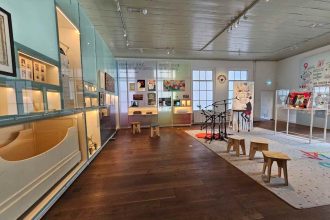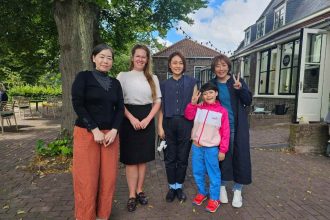Under the CAT program, AIT staff, Rika Fujii and Naoko Horiuchi, traveled to the Netherlands in July 2023, visiting museums, welfare organizations, and art spaces that practice art and mental health in both the art and welfare fields. Tomoko Nishida, a mental health social worker involved in the CAT program as a facilitator, accompanied AIT staff on this research. This report presents Ms. Nishida’s perspective as a mental health social worker in Japan.
A place where individuals are encouraged to make their own choices
What I felt most strongly through this research visit and considered as the most important point was that people’s “own choices on how they lead and build their lives” was consistently respected in all the places that I visited.*1.
As Japan and the Netherlands have completely different historical backgrounds and cultures, it is difficult to make a simple comparison, however, I felt that an important point that was missing from the current services in Japan was always present, especially in the Netherlands, which I thought was the decisive difference.
In Japan, the use of mental health services has shifted from measures to contracts, and on the surface, it appears as though the services can be determined by medical care recipients/patients. However, the actual situation is very different. Further, in terms of self-expression, although patients should be able to freely express themselves, if a patient draws a picture of one’s own experiences, that patient’s condition is judged to be “unwell,” resulting in the type and amount of medication being increased or that patient being hospitalized, even though he or she does not wish to do so.
In our country, there are many situations that give the impression that patients and the medical professionals or service providers are not equal, and this reaffirms the point that the patient is deprived of the chance to make choices, as they are considered as not having the insight or the ability to make decisions about their illness, even though it is his or her own life.
The medical system and welfare service delivery channels in the Netherlands and Japan are very different, and it is not possible to simply compare the two countries, however, through this research visit, I wanted to explore how mental health services in the Netherlands have changed.
Below is the summary, focusing on the two most impressive places we visited during this research.
Initiatives of Care Farms Spreading Across the Netherlands
In the Netherlands, the combination of agriculture and welfare services has existed since before the industrial revolution*2.
Most of them used the AWBZ (Algemene Wet Bijzondere Ziektekosten / General Law for Special Medical Expenses: enacted in 1968), which provides cash payments and services in kind for special needs. The government paid a premium for care farms operated by AWBZ-approved facilities, which in turn provided income to farmers. However, the income was small, and many care farms operated mainly on the income from farming.
Subsequently, there was a major change in the system, and a personalized care budget called PGB (Persoonsgebonden budget: social experiment in 1991, full-scale introduction in 1995) was established. This is a cash payment system that allows the person to pay for the services he or she deems necessary. The idea is that it can be paid for services outside of the professional field and can be paid to care farms or for nursing care from family and friends.
The creation of the personalized care budget (PGB) allowed care farms that were not designated under AWBZ to provide services, and the number of care farms increased dramatically from 75 in 1998 to 1,000 in 2009.
The PGB has brought about a change in the users. The users expanded to the elderly, children, youth (especially the number of mental health service users under the age of 18 has increased), and the mentally disabled. Care farms had mainly engaged in agriculture with welfare following, however, with the change of the system, there are more care farms gaining revenues mainly from welfare.
The PGB system is behind the increase in the number of care farms, and I felt that it is important, as the basis of consideration, to enable people to choose and use services on their own, regardless of whether those services are formal or informal. The care farms we visited were impressive in that young people with difficulties in life and people with dementia were able to use the service at their own pace and that they appeared to be so full of life.
An art museum open to everyone, and the history of psychiatric care
Like Japan, there was a time when the Netherlands had more psychiatric beds than any other country in the world, and like Japan, there was a time when people lived in isolation as psychiatric treatment (as of 2011, surpassing all other countries, Japan ranked first in the world in terms of number of psychiatric beds, while the Netherlands ranked third.)
During the time when isolation policy was taken, Dolhuys was a sanatorium. In Japan, psychiatric treatment was subject to the same isolation policy as leprosy and tuberculosis, leading to the concentration of psychiatric hospitals in the Tama region of Tokyo.
The sanatorium was closed off from rest of the area where people lived, and there was no interaction. It was a world in which everything was done inside the facility.
It is significant that Dolhuys had gone through such a period and now exists as a place that is open to everyone in the community. The exhibit at the museum showed the history of people with mental illnesses who were supposed to be treated but were deprived of: their individuality; expressing themselves; taking charge of their own lives; making choices and leading their life. The exhibition was impressive in that it introduced those who did not give up on expressing themselves and exhibiting their works, but also raised questions about living with various stigmas, not only mental illness but also as immigrants and women.
Around 2011, the Netherlands experienced an economic crisis and was forced to cut taxes in many areas. In particular, the budget for psychiatric care was huge, and the number of psychiatric beds was subject to drastic cuts. The health care system itself underwent a major shift, from a national system to one run by insurance companies. Although many problems are still pointed out in this regard today, it also led to psychiatric treatment to be developed in the community (7-9% reduction in psychiatric beds per year).
The drastic reduction of beds has resulted in the eruption of many problems, including the degrading of mental health services, an increase in the number of delirious people being taken into police custody on the street, and staff layoffs. As a countermeasure, it was decided to promote outreach, and FACT *3 (Flexible Assertive Community Treatment)was deployed.
Similarly in Japan, the budget for psychiatric inpatient treatment is a major problem, however, even after decades, there has been no significant change, and the options for psychiatric insurance services available in the community continue to be scarce. Although some municipalities have established outreach teams and the number of home-visit psychiatric treatment services has been increasing in some areas, I reconfirmed that the variety and quantity of services that enabled the patients to freely choose as they want were insufficient.
In the Netherlands, there is a system of home doctors (Huisarts), and patients are connected to specialized treatment through their home doctors. However, the long waiting period and inability to receive necessary specialized medical care in a timely manner is one of the major problems.
Through this research visit, I learned that not only is expressing one’s own worldview and experiences through works of art is therapeutic, but also that there is a mechanism in place to receive compensation in the form of renting or selling such works of art. I felt that this is a wonderful system because it is directly related to the importance of not only expressing oneself but also earning compensation through one’s activities and connecting with society.
I also keenly felt the importance of trying to adopt what we think is good to the extent possible, although institutional reform is also necessary. Although Japan, the Netherlands, and Germany have significant differences in historical backgrounds and cultures, there is no difference in the fact that everyone has the right to live his or her own life and make his or her own choices. I felt that I wanted to be involved in providing as many options as possible through accessiblefamiliar support, and to ensure that no one is deprived of their right to make choices.
In Japan in particular, professionals and patients are often not on equal footing, and it is common for professionals to deprive patients of their choice to “take on challenges even if they may fail.” This is often done unconsciously by professionals viewing that “patients do not understand the current situation due to their medical conditions and do not have the ability to understand because of their disability, and that the experts know the right answer and will provide support toward the right path.”
Japanese mental health services have focused exclusively on treatment of illness and support for disabilities. However, the idea of recovery support has been spreading in recent years.
Recovery means that everyone can live life as they wish, express themselves freely, and realize the life they desire, even if they have many difficulties in life.
I would like to work toward realizing a society that recognizes that happiness and comfort differ from person to person and that everyone can challenge themselves to achieve the life they desire, rather than imposing the values of those around them.
One of the concrete actions I have begun to take after the research visit is to participate regularly in The European Community based Mental Health Service Providers (EUCOMS) Network (established in 2015), which has its secretariat in the Netherlands, to exchange information.
I would like to make the most of the connections I have made outside my field of expertise through this research visit, so that I can contribute to recovery for all people in the community in Japan.
*1 At Cordaan, one of the welfare organizations we visited during our research in the Netherlands, a system was in place to respect the decisions of individuals with any disability who are capable of making their own decisions, and to connect them to welfare services in line with their wishes.
*2 Care farms are extensively used in the Netherlands as an alternative to day care centres for people in need of care, including people with dementia. The care is often organized in smaller units, in which personal care and daily routines are integrated. The care staff performs tasks such as cooking, cleaning and gardening together with the participants.
(From AGE Platform Europe Website)*3 FACT: The Netherland’s Flexible Assertive Community Treatment for mental illness (2003 – ongoing) | Centre For Public Impact (CPI)
Text:Tomoko Nishida
-
Tomoko NishidaNishida is a mental health social worker, providing support to people who wish to "live as they are even though they have difficulties in their lives". Currently, her activities are focused on outreach programs at clinics and local governments.







